- Home
- Elizabeth Knox
Daylight Page 2
Daylight Read online
Page 2
His phone rang. It was Gino. He said, in English, that he was gathering the necessary experienced bodies and their gear. “You put this detective on to me?” Gino said. “Mr. Phelan? Did you tell him you are with the police also?”
“No,” said Bad. “There’s a question mark over that.”
“He said you gave him my number and then disappeared.”
“I’m above Riomaggiore, keeping my eye on the action. I volunteered your expertise, Gino, not my own.”
“When we arrive will you be there?”
“Sure.”
“Are you going to want to be on a rope, Bad?”
“Yes.”
“Hauling or in the surf?”
“I was on a rope last week, Gino. I’m completely fit.”
Gino changed tack. He said that, earlier in the week, Bad’s girlfriend, Gabrielle, had been by his apartment to collect the bag she’d stored there.
Bad asked if she’d said anything.
“She said she wasn’t your ideal audience.” Then, “Bad?” said Gino, into his friend’s silence.
“Okay, mate, I’ll meet you there,” Bad said. “At the edge.”
Before Bad’s work-related accident he and Gabrielle had been “going out,” to parties, movies, barbecues, her colleagues’ polo games. She stayed over at his place, he at hers. They took a friendly interest in each other, and pleasure. They would agree that they’d had some important talks, several about the sad neediness of other couples they knew. These conversations were a kind of orientation exercise: they worked out where they were in relation to their expectations of themselves. They discussed dependence and independence—but never considered interdependence. Bad once overheard Gabrielle saying proudly to her friends, “Brian and I don’t like to live in each other’s pockets.”
After Bad’s work-related accident he moved in with her and she declared that she wanted to get to know him—really. “Remember Woman of the Year?” (They had seen a new print at the film festival.) “Well, unlike Katharine Hepburn, I do know how my man likes his eggs. But I don’t really know what makes him tick.”
“Am I ticking?” said Bad.
The bomb that had injured Bad had been under a car in a garage beneath a concert hall. Two cardboard pizza boxes had been taped together, one on top of the other, with a visible timer attached. The police emergency ordnance disposal team X-rayed the package at different frequencies before detaching the timer and freezing the whole thing with dry ice, in order to retard its detonation time. They guessed that there was probably another detonator concealed underneath it, on anything from one to five seconds—five to ten at minus ten degrees Celsius. Bad’s colleagues did what they could, then moved back. Bad was told to take in his Predator robot to pull the package out and turn it over. As Bad maneuvered his Predator, he thought about his psych instructor, who used to say, about bombs costumed in dummy timers, “If terrorism is a theater of war, then bombers know the bomb squad are theater critics. They are going to want you to know, if only for an instant, how artful they’ve been.”
The garage was still. There was a static cough from a radio. Red and blue lights bounced off the clean glass and paintwork of the concertgoers’ cars. Bad, blinkered by his helmet, entombed in his armor, performed the tai chi of a robot controller. He got the Predator’s arms in under the car and inched the box out. The reading by his left eye said the box weighed twenty kilos. More than it should. (That was the lead plate, millimeters thick, shielding the detonator from prying X rays.) Camera two, on the Predator’s antenna, showed no wires running from the box, no mooring of booby trap to explain the resistance. Bad had time to say, “I’ve got a weird figure on its weight. Is there any known ordnance …?” Then he saw that the cement was rougher in a patch under the box. That it wasn’t cement but packed sand. And he thought he saw the shining blister of a switch on which the twenty kilos of lead sheeting—and nothing else—had pressed. A small antipersonnel mine was embedded in a sand-filled hollow under the car. The emergency ordnance disposal team had thought that the car was the target, but the car was the bomb itself, and loaded with explosives.
A shock ran along the umbilicus from the Predator, a burst of feedback. Static, then blackness, no signal. A brutal concussion wave threw Bad ten meters backward. The fire followed him, bright even through his blast shield, flames accelerating toward him, unstoppable—till a lid slammed down on them, a concrete slab, part of the floor above, five by five meters and twelve centimeters thick. It landed at an angle, its lower edge against the sole of Bad’s right boot, its upper edge wedged against one of the garage’s main supporting pillars, on which there was a poster for an exhibition of European Modern Masters. Bad saw sparks, and the cement chipped by shrapnel. He watched the band of yellow and black paint on the pillar’s edge blistered by heat. The poster was on the pillar’s sheltered side, but the air got under it and made it pulse, then billow free and fly at him, its edges catching fire and burning in toward the pure heart-shaped face of Jean Ares’s Eve in a Gaucho Hat. Bad saw Eve consumed by a closing iris of fire. Then he lifted his head and looked for his hands.
His hands were whole, and holding his girlfriend’s motivational book. He was up to chapter 3: “Solid Approaches to Infirm Positions.”
The afternoon light was changing color now, slanting down the terraces above Riomaggiore, touching their tops but not their steps. It was, Bad thought, the kind of light that seems to look over your shoulder, like sunlight in a church. It made him feel embarrassed by the book, so he closed it, put it in his pack, got up, and went back along the top path and down into Riomaggiore.
When the sun was only its own depth above the mountains everything was finally ready. They had three rigs, and Gino and Bad were on separate lines, with the battered chicken-wire Stokes basket on its own line above them. Gino had brought Bad’s caving gear and his wet suit. Only he and Gino had wet suits—all Gino’s cave-diving friends were down a system in the Dolomites, helping out on a mixed-gas dive.
The cove was entirely in the shade. Beyond the station and the resurgence of the rail line between two tunnels the rock face was a darkness checked by gray vapor, a chain-link fence put up to catch falling rocks. Above this the terraces were sun-striped, the golden air grainy with insects working spring flowers. In the light even the businesslike regularities of laid cordage—prusik hitch and alpine butterfly—were all magically vivid. The jumars and the worn rollers of the brake bar racks were all objects the climbers took good long looks at and, not believing their eyes, rattled and wriggled and yanked.
Gino switched on his helmet lamp. He said that all he’d told the detective, concerning Bad, was that he knew what he was doing. “And nothing about your injury.”
“I’ve been climbing,” Bad said. “You were there.”
Yes, Gino said, and Bad wasn’t on the same rope as him, and the woman in the water was dead. “So.” Gino shrugged. “And I told him you were police. That made him happy. But here he comes.” Gino climbed over the fence. Bad turned on his own headlamp and looked up at the detective, who blinked in its beam. Bad crossed the fence, too, and clipped his jumar onto the lines coming under its rails, lines that ran over the padded edge of the path and the rollers of stainless steel racks. Bad took off his sunglasses and passed them to the detective, then let himself down, caught the lower edge of the concrete path in one hand, and pushed off. The rope ran out three feet and Bad swung into the shadow. His boots connected with the cliff face and he bounced out again and began to abseil quickly down.
Bad glanced up once to see that Gino was well over to one side, dislodging a litter of pebbles from the cliff, but none that fell anywhere near. High above them Bad could see the underside of the path, its straight edge interrupted by several craning heads and the lit transparency of smoke from the brake bar racks, heated by friction.
Bad stopped within two meters of the surf and braced his legs against the cliff. Gino appeared beside him and they watched as the Stokes basket w
as lowered, revolving slowly. Gino gave Bad a thumbs-up—they were using hand signals, unable to make themselves heard above the surf. Gino raised his arms to catch the basket, clipped himself onto its line, made an OK with his gloved hand, and spoke into the radio on his harness. Bad tightened the strap of his helmet and let himself down into the water. He felt the confused pressure of a boil, then the drag out and, in the next instant, the push in. His feet sought and found the rock at the cave mouth. The tread on his soles caught on its surface, rough under a soft layer of seaweed. Bad looked into the cave, saw that it was around three meters deep, with a small water chamber, its roof higher than its opening. Bad’s taut rope and braced legs kept him outside, but the seaweed provided lubrication between his feet and their foothold. He looked up at Gino, who had his ear down to the radio. Gino began to relate information from the people above, about the waves. Bad was to wait for a low set. He waited. Then, on Gino’s signal, Bad let out his line enough to crouch on the rock. He found a handhold seaward and reached his other hand back to the body as it rolled his way in the slow drain of a backwash. He slipped his hand into the waistband of her trousers. As he did he remembered the previous evening, his anxious reflex snatch at the Swiss girl as she set out along the cliff path. Bad bent both elbows, his upper body a closed spring, and hauled the body partway up onto the rock. Her rigid legs still pointed back into the cave.
A wave went under Bad and he felt it refloat the body. He gave a hard tug and she slid closer, emerging from the foam, her skin blistered, not by bursting bubbles but blister upon blister, some still full of straw-colored lymph, some open and red, with filmy white skin at their rims.
Bad waited out another wave and then looked up, gave Gino the nod. The basket began to descend. Bad put his head down to hold on through another wave, this time focused on the pulls on the fabric of the victim’s knit top.
This woman’s long hair, paler at its roots, didn’t look like a dark dye job and regrowth. The color was blended gradually from roots to ends, gold to brass to amber to brown. The hair was a mess, a matted mass after her time in the sea, but the color was memorable. Bad had seen a similar unlikely high-maintenance dye job once before—a woman with blond roots graduating to brown ends, her face in a blur of pallor, as if a light shone out of her scalp. He remembered her because there had been weeks when he’d hoped he’d see her again or hear she’d been found. She was never found. That was nine years ago, but for a crazy moment Bad thought he’d found her in the sea cave at Riomaggiore. Found her finally, dead, as he’d expected her to be.
The basket lightly tapped Bad’s helmet. He freed a hand to pull it down onto the rock, then clambered over the body and dropped down into the water inside the cave. He took shelter behind the rock from the full horizontal force of a slightly bigger wave. The wave formed an eddy behind him, rolled against the roof, turned wholly white with trapped air, and pushed Bad under. He waited for the pressure to diminish, and gripped the woman’s ankle in one hand. When he came up for another breath, he found the basket above him and wrestled it down into the water. Before the next wave swamped him he saw Gino abseil down and set one boot on the back of the corpse. Bad closed his eyes and held his breath. The wave relented, but rather than letting him up it thrust him onto the rock. The basket surged up too, and punched him in the armpits. Then it dropped into the water behind him, disappeared, and reappeared, a sieve for foam.
Gino got his attention, gave his shoulder a soggy slap. The body was rolling across the rock. Bad lifted his feet and let her roll under him—then he jerked the harness on the basket. It scooted toward him, and the body tumbled into it.
Bad fumbled for the straps. Gino shouted at him—then shrank from Bad, grew smaller, rappelling out from the rock and hauling himself up a number of feet. Bad saw Gino wrap his leg around the slack rope on the Stokes basket. A big wave came at the cave mouth, broke, and poured only part of its volume into the hollow. As it hit, Bad saw Gino buried and pushed against the cliff face. He saw Gino’s rope-wrapped leg emerge from the white wall and into the cave. Then the cave filled and Bad was thrown up against the top of its water chamber. His helmet hit the rock roof with a crack. He was spread-eagled, and the Stokes basket rose diagonally on its taut rope and pushed against him. Bad put his gloved hand against the corpse’s neck and held her down, held her in place. He felt the basket pulled sideways, but the water wasn’t withdrawing yet. Bad clung to the corpse and basket and put his head down so that he could clear the cave mouth as, with the help of the hauling team above, Gino—acting as a human redirection pulley, his wet suit puckered and stretched, his leg rope-burned beneath it—pulled Bad and the Stokes basket right out of the cave. They poured out with the wave.
Bad was again suspended; he and the basket swung dripping for a moment; then the big following wave covered them and Bad kicked out to fend off the cliff face. The sea had his legs. Then it didn’t have them, and he was making slow but steady upward progress, the hauling team hard at work far above him. Gino swung toward him and together they got the body’s right leg and arm back in the basket and closed the remaining straps.
Gino joked that he now had one leg longer than the other. The beams of their lights crossed and parried as they peered at each other’s faces, arms, and legs. The sun had gone behind the mountains and, in the dusk, the water below them glowed, a blue-shadowed white. It crashed and raved and Gino remarked that these waves were the big set; the one that carried Bad into the cave merely came in at a difficult angle. “Fifteen seconds more,” Gino said, and smashed his fist into his palm.
Gino was exhilarated, Bad could see. As for Bad, he felt as he had hoped he would, finally thoroughly cleaned of something—something dimming rather than dirty—as if the pizza-box bomb had filled his soul with gloom, a shrapnel of small shadows.
Together Bad and his friend turned their faces and headlamps down to the basket’s load. Water dripped from the rim of their helmets and Bad could hear, against the surf, small puck puck sounds of drops on taut cloth. They looked at her face; then Gino’s light moved and let Bad see where Gino was looking. Her shirt was rucked up, and the skin on her midriff was innocent of blisters.
At the top of the cliff the paramedics bagged the body. Bad showed them his hands, the palms of his wet gloves to which matter had adhered. He was asked to take them off and saw them bagged, too. Then he went and shook hands with the hauling and belay teams—Gino’s caving friends and some firefighters from La Spezia. Gino asked him how his neck was. He’d noticed that Bad’s helmet had taken a bit of a beating.
Bad said, “My neck is fine.”
Gino was smoking, which always amused Bad. He was used to Sydney firefighters, who, for the most part, were disinclined to smoke.
The body was carried off and the rig dismantled and packed.
“This will need cleaning,” said someone, about the basket.
“I’m going to act helpless at this point,” Bad whispered to Gino, who glanced at him, then turned fully and came close to Bad, excluding everyone else. “We both did several stupid things down there,” he said.
“Yes, I know.”
“So long as you know.”
Gino had come with as much gear and as many hands as could be spared, though he hadn’t been able to muster many off-duty firefighters—with the trains on strike the region’s emergency services anticipated problems on the roads. Still, Gino’s van was filled to capacity, so Bad caught a lift back to Genoa with the detective.
The detective complimented Bad on his French. Bad said thanks, but he was sure it didn’t pass muster with the French. All credit was due to his grandmother, who had grown up on Jersey Island. But Bad had been in this part of the world before. Nine years ago. He’d met Gino then. Gino had rescued him from a flooded cave. He’d stayed at Gino’s parents’ place in Dolceacqua. Still, his Italian wasn’t a patch on his French.
Bad was sleepy. He slid down in his seat.
The detective overtook a truck in the tunnel
and surged out into the open air. The detective’s phone rang. A hands-free car phone, thank God.
Bad yawned. His jaw clicked. He listened to the detective ask questions, heard the detective use a name he’d been idly trying to recall—the name of the village at the lower end of the big cave system in which he’d met Gino. The whole system had flooded in ’92, and Gino’s zona had been looking for trapped cavers.
“Dardo,” said the detective. Then, “Martine Dardo.”
They went into another tunnel. The truck overtook the detective.
“I hope you won’t mind if I drop off,” Bad said. “My room last night was above the rail line.”
The detective told Bad that the woman had a credit card in the back pocket of her pants, which greatly simplified things if it was her credit card. They had an address already, financial records, the name of a lawyer and next of kin. She’d have to be identified, of course. “Martine Dardo,” the detective said. “It sounds very familiar.”
Bad felt rather clever. He told the detective that Dardo was the name of a village just across the border. “A French village with an Italian name.”
“An Italian village that chose with its head, not its heart,” said the detective. “But it’s the whole name—Martine Dardo—that is familiar.”
They emerged from the tunnel.
“Tell your guys to put it into Google,” Bad said.
The detective got his subordinate’s attention and asked him to put “Martine” plus “Dardo” into a search engine.
GENOVA, said a sign—without a distance. Bad hunkered down and closed his eyes. He thought of the air mattress on the floor of Gino’s living room.

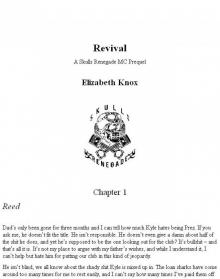 Revival
Revival Santa's Naughty Helpers
Santa's Naughty Helpers Chaz (Reapers MC Book 14)
Chaz (Reapers MC Book 14) Deceit (The Clans Book 4)
Deceit (The Clans Book 4) Wait on Me (Knights of Retribution MC Book 2)
Wait on Me (Knights of Retribution MC Book 2) Bossed Up (Iron Vex MC Book 2)
Bossed Up (Iron Vex MC Book 2) Booger (Reapers MC Book 3)
Booger (Reapers MC Book 3) Degrade: A Dark Mafia Romance (DeLancy Crime Family Book 1)
Degrade: A Dark Mafia Romance (DeLancy Crime Family Book 1) Chaos: A Reapers MC Boxset
Chaos: A Reapers MC Boxset Zorro (Reapers MC Book 16)
Zorro (Reapers MC Book 16) Venomous (The Clans Book 11)
Venomous (The Clans Book 11) Zane (Reapers MC Book 11)
Zane (Reapers MC Book 11) Hate on Me (Knights of Retribution MC Book 3)
Hate on Me (Knights of Retribution MC Book 3) Web of Lies
Web of Lies Hammer (Reapers Rejects MC Book 18)
Hammer (Reapers Rejects MC Book 18) Consumed: A Driven World Novel (The Driven World)
Consumed: A Driven World Novel (The Driven World) Anguish
Anguish Frost (Reapers MC Book 15)
Frost (Reapers MC Book 15) Alluring Allies
Alluring Allies Covert (The Clans Book 9)
Covert (The Clans Book 9) No Limits: A Taboo Anthology
No Limits: A Taboo Anthology Malicious: A Nomad Biker Novel (Raiders of Valhalla MC Book 1)
Malicious: A Nomad Biker Novel (Raiders of Valhalla MC Book 1) Venom's Secret (Iron Vex MC Book 4)
Venom's Secret (Iron Vex MC Book 4) Forbidden Love: Book 1 in the Mackenzie Series (Leave Me Breathless World)
Forbidden Love: Book 1 in the Mackenzie Series (Leave Me Breathless World) Twisted Steel: An MC Anthology: Second Edition
Twisted Steel: An MC Anthology: Second Edition Mouser (Reapers MC Book 9)
Mouser (Reapers MC Book 9) Sharp Edges (Full Throttle Book 2)
Sharp Edges (Full Throttle Book 2) Blackjack
Blackjack Reckless
Reckless Blood & Torment (Pins and Needles: Moscow Book 2)
Blood & Torment (Pins and Needles: Moscow Book 2) Demise (The Clans Book 13)
Demise (The Clans Book 13) Defiant (The Clans Book 6)
Defiant (The Clans Book 6) Flawed (The Clans Book 12)
Flawed (The Clans Book 12) Amara (Reapers MC Book 12)
Amara (Reapers MC Book 12) Widow (Reapers MC Book 4)
Widow (Reapers MC Book 4) Callous King (The O'Dea Crime Family Book 1)
Callous King (The O'Dea Crime Family Book 1)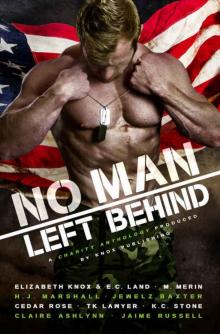 No Man Left Behind: A Veteran Inspired Charity Anthology
No Man Left Behind: A Veteran Inspired Charity Anthology Finley's Adoration
Finley's Adoration Sinister (Raiders of Valhalla MC Book 2)
Sinister (Raiders of Valhalla MC Book 2) Ruthless (The Clans Book 8)
Ruthless (The Clans Book 8) Filthy Valentine: A Dungeon Demons MC Prequel
Filthy Valentine: A Dungeon Demons MC Prequel Havoc- Reapers MC Boxset
Havoc- Reapers MC Boxset Mayhem: A Reapers MC Boxset
Mayhem: A Reapers MC Boxset The Absolute Book
The Absolute Book Dangerous Love (Mackenzies Book 3)
Dangerous Love (Mackenzies Book 3) Omen's Sign (Iron Vex MC Book 5)
Omen's Sign (Iron Vex MC Book 5) Call My Bluff: A Las Vegas Themed Anthology
Call My Bluff: A Las Vegas Themed Anthology Blood & Agony: A Dark Criminal Romance (Pins and Needles: Moscow Book 1)
Blood & Agony: A Dark Criminal Romance (Pins and Needles: Moscow Book 1) Tough as Steele (Steele Bros Book 1)
Tough as Steele (Steele Bros Book 1) Dixon (Reapers MC Book 10)
Dixon (Reapers MC Book 10) Stripping a Steele (Steele Bros Book 2)
Stripping a Steele (Steele Bros Book 2) Deprave (DeLancy Crime Family Book 2)
Deprave (DeLancy Crime Family Book 2) Vex's Temptation
Vex's Temptation Stripping a Steele
Stripping a Steele Dreamhunter
Dreamhunter The Trade
The Trade Against All Odds (Full Throttle Book 1)
Against All Odds (Full Throttle Book 1) Call My Bluff
Call My Bluff Sydney's Battle (Reapers Rejects MC: Second Generation Book 1)
Sydney's Battle (Reapers Rejects MC: Second Generation Book 1)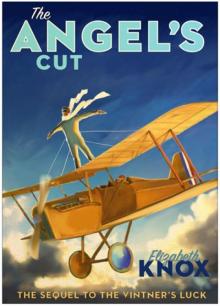 The Angel's Cut
The Angel's Cut Dreamquake
Dreamquake Dreamquake: Book Two of the Dreamhunter Duet
Dreamquake: Book Two of the Dreamhunter Duet Reckoning (Skulls Renegade MC Book 5)
Reckoning (Skulls Renegade MC Book 5) Darkness (Darkest Nightmares Book 1)
Darkness (Darkest Nightmares Book 1) Switched (Sin City Fets Book 1)
Switched (Sin City Fets Book 1) After Z-Hour
After Z-Hour Axel (Reapers MC Book 17)
Axel (Reapers MC Book 17) A Visit to the House on Terminal Hill
A Visit to the House on Terminal Hill Scarred (Demons of Hell MC Book 1)
Scarred (Demons of Hell MC Book 1) Stolen Hearts: A Dark Billionaire Collection
Stolen Hearts: A Dark Billionaire Collection Promised (The Clans Book 1)
Promised (The Clans Book 1) The Trade (The Clans Book 2)
The Trade (The Clans Book 2) Revenge
Revenge Daylight
Daylight Redemption
Redemption Overzealous Alphas
Overzealous Alphas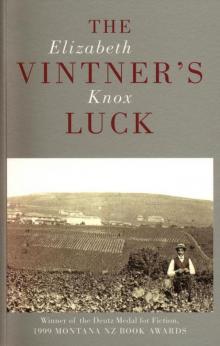 The Vintners Luck
The Vintners Luck Wake
Wake Corrupted Love: A Dark Mafia Romance (Mackenzies Book 2)
Corrupted Love: A Dark Mafia Romance (Mackenzies Book 2) Mortal Fire
Mortal Fire Reckoning
Reckoning Tough as Steele
Tough as Steele Scarred
Scarred Relentless (Skulls Renegade Book 4)
Relentless (Skulls Renegade Book 4)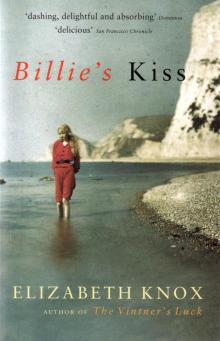 Billie's Kiss
Billie's Kiss Reclaimed (Skulls Renegade MC Book 6)
Reclaimed (Skulls Renegade MC Book 6) Deceptive Love: A Dark Mafia Duet (Mackenzie & Volkolv Book 1)
Deceptive Love: A Dark Mafia Duet (Mackenzie & Volkolv Book 1)